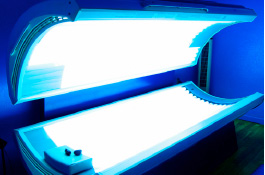- Teens and Tanning- What are the risks? - September 14, 2012
Summer is here once again; that means school is out and it is time to enjoy the sun…or is it?
 In a culture where being tan is considered “healthy” and “attractive”, more than 2.3 million teens are jumping into tanning beds each year, ensuring the success of thousands of tanning salons. Instant tanning sounds fun and easy, but the alarming increase in the rate of skin cancers among youths does not. In fact, the number of cases of melanoma, the most deadly type of skin cancer, has more than doubled since 1975 among women 15- 25. More frightening still, 90% of pediatric melanoma occurs in girls who are 10-19 years old.
In a culture where being tan is considered “healthy” and “attractive”, more than 2.3 million teens are jumping into tanning beds each year, ensuring the success of thousands of tanning salons. Instant tanning sounds fun and easy, but the alarming increase in the rate of skin cancers among youths does not. In fact, the number of cases of melanoma, the most deadly type of skin cancer, has more than doubled since 1975 among women 15- 25. More frightening still, 90% of pediatric melanoma occurs in girls who are 10-19 years old.
What are teenagers doing to create such a spike in cancer rate?
Statistics show tanning is becoming more popular than ever, while sun protection is increasingly unpopular.
American Academy of Dermatology (AAD) survey showed that more than 80% of people under the age of 25 consider themselves more attractive with a tan whereas only a third of them use adequate sunscreen.
Over 37% of white female adolescents in the aged 13-19 have reported to using indoor tanning facilities. It isn’t a surprise that indoor tanning has become a $5 billion-a-year business.
We are constantly told about the dangers of using sunbeds. However, some teens are choosing to ignore the risks; they may even rationalize it saying that sun exposure is good for your health. Half of kids who use who use these beds do not consider them as being riskier than other activities. This may be due to denial or ignorance but regardless, tanning beds are currently placed among the top most harmful carcinogens.
Why do teenagers tan?
Some studies have shown frequent tanning may release endorphins, which may addictive, just as nicotine does. However, it is increasingly obvious that these teenagers are making a conscious choice of beauty over health. They truly believe, though, that skin cancer will not happen to them.
Why is tanning dangerous?
Tanning is especially harmful in teens because:
- Even one blistering sunburn in children may double the risk of developing skin cancer later in life.
- Teenagers may be especially susceptible to skin cancer since their cells are still changing and dividing more rapidly than those of adults.
- Exposure to UV rays, even without sunburn, spurs the growth of moles, which are risk factors for cancer development in the future.
Is skin cancer truly dangerous?
Skin cancer is treatable if it is:
- detected early
- a favorable type
- has not metastasized (spread throughout the body)
… That’s a lot of “if”s to bet your life on.
Early detection
Since most cancer cells grow on the epidermis (the outermost layer of the skin), tumors are often seen faster than cancer of a more “hidden” organ, like the lungs or prostate. There are three major types of skin cancer: basal cell, squamous cell, and melanoma. Of these, squamous cell and melanoma are the most likely to be fatal.
Surgery or radiation can effectively treat basal cell and squamous cell cancer, but these treatments may be disfiguring and disabling. Most severe, melanomas metastasize frequently and often lead to death. The chance of survival for melanoma is 99 percent if detected in its earliest stage, but quickly drops to 15 percent once it moves beyond the skin. Worse still, even those who recover are at a high risk for the disease to recur.
How can I prevent myself from getting skin cancer?
Indoor tanning facility users are 74% more likely to develop melanoma than people who have never tanned indoors.
The best way to avoid getting cancer is to avoid its cause: harsh UV rays. To do this you can simply:
- avoid sun exposure, especially during peak hours
- Use sunscreens correctly
- wear protective clothing and sunglasses
The most important thing we can do is truly educate teenagers about the risks of tanning beds and unprotected sun exposure. Skin cancer is almost always a preventable disease.
Read patient stories about Dr. Hootan Zandifar from the Skin Center, at the internationally renowned Osborne Head & Neck Institute.
To learn more about Dr. Zandifar and other facial plastics procedures offered at the internationally renowned Osborne Head and Neck Institute visit our website at: http://www.ohnifacialplastics.com





